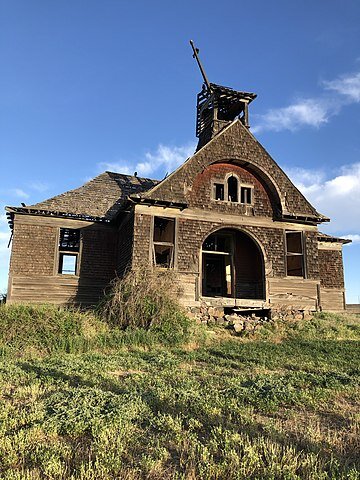Date of Establishment
After the construction of the Central Washington Railway in 1889, Govan was the spot to be. The town boomed in 1890 and sand extraction was a bustling business to support this railway town. Govan was a small farm town, with merely two churches, a post office, one school, and a handful of businesses. Even once the town boomed a disastrous fire claimed the town, sending it back into the ghost town era. This central Washington ghost town only has 3 residents to this day, a married couple and one other local.
Name & Location

The abandoned town of Govan, WA sits about 50 miles west of Spokane, just down Highway 2 in Lincoln County. The town’s name is derived from R. B. Govan, who was an engineer for the Central Washington Railway.
Psychical Description
Govan was a large sandbank area in Lincoln County WA. With large plains of sands and minimal foliage to remove, it became easy to settle in the late 1800s. In the 1900s the town would have had full streets, schools, shops, and diners. Machines and railway workers digging pits of sand out of the countryside it would seem.
However, by 1933 Govan would be declared a passed by the town as US Route 2 came along. The town grew old, beaten down, and ghostly to outsides. Locals themselves ever relocated and moved on to better things. Leaving the barren mark of what was, and can never be again.
Origin
One haunting lead back to 1902 when a robbery leads to “the most brutal crime” committed in the county. Judge J.A. Lewis and his wife Penelope were murdered during a robbery, but being hacked with an ax. Mr. Lewis was known to keep large sums of money at his estate. Police concluded that was the motive, yet never solved the case and caught the killer.
Years later C. S. Thennes was killed by a masked gunman in the Govan Saloon. The saloon no longer stands today, as most of the business district of Govan, which was destroyed in the fire of 1927. Many believed that locals focusing on rebuilding the town, rather than avenging their dead helped to “haunt” this ghost town.
In 1941 a woman was founded murdered on her farm property, and her son went missing. Eight years later the son’s body was found in the fields on the property. Some claim this is the reported “shadowy figures” seen in the distant fields.
Along with the murders going on in the town, and the first fire, the town was once again seeing tragedy. A second in 1974 left the town unfixable in many local eyes and marked the end of Govan. Many homes and families were affected and even suffered losing loved ones. Within that fire burned most of the written records for the town, so linking any spirit to a real person is undoable.
Mythological and Lore
Although today most of the buildings from this ghost town are gone, a few remain that were from the town’s heyday. One of these is the Govan School which closed in the 1940s, but still gets visitors today. Some leave trinkets, shines, candles, and boxes of keepsakes at the schoolhouse. The residents the Sullivan’s reported have everyone from thrill-seekers to photographs come out to the property.
Various sites around the internet back up claim that the schoolhouse is haunted by shadowy figures. These figures are supposed to be the murder victims attempting to draw attention to the unsolved crimes. Yet, past a few bolstering claims there is little information on the Govan haunting. Few claim to see a shadowy or formless figure in windows or around the surrounding wheat fields. Most visitors claim to have a pleasant experience around the ghost town, however, that doesn’t stop urban tales. The creepy and rundown presence of the last few standing buildings surely adds belief to the “haunted” rumors and tales.
Many photographs visit the old schoolhouse to get some amazing shots of the skies. However, every few have commented past an eerie feeling and overload of spider webs. Some have claimed they may have seen, felt, or hear something ominous; but chalk it up to their minds playing tricks. Most visitors report known about the ax murderer as well as the saloon, which does lead them to be on guard for the paranormal. You will have to take a visit to make the choice between beautiful or haunted.
Modern Pop-Culture References
Movies
- The Govan Schoolhouse (2019) [Youtube]
Index
- Run of the River
- Ghost Towns of Washington
- King5.com
- Pacific Northwest Photoblog
Is there anything we missed about “Govan, WA”? Let us know in the comments section below!


